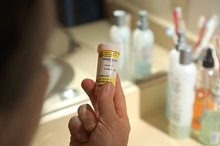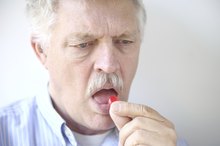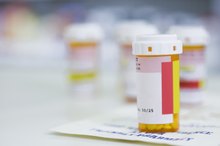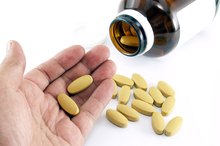Symptoms of Niacinamide Overdose
Niacinamide is a medication used for the treatment of pellagra, a disease that occurs due to a lack of vitamin B3 in the body. Vitamin B3 is essential for normal functioning of the cells in the body. Niacin is a vitamin B3 supplement. Pellagra causes stomach and skin problems as well as dementia and death. The usual dose of niacinamide is 100 mg to 300 mg daily; however, actual doses can be higher or lower depending on the individual patient's needs. An overdose of niacinamide causes negative effects.
Gastrointestinal Problems
Stomach upset -- such as abdominal pain, cramps, nausea, diarrhea and vomiting -- occurs when niacinamide is taken in appropriate doses. In the situation of an overdose, stomach upset worsens. Niacinamide can be taken with or without food; however, if stomach upset occurs, it should be taken with food to reduce the severity of the stomach upset. Niacinamide also causes loss of appetite and fluid retention in the stomach. Niacinamide can worsen existing ulcers, manifesting as black stools that may or may not be bloody. Ulcers are serious and should be reported immediately to a medical professional for treatment.
- Stomach upset -- such as abdominal pain, cramps, nausea, diarrhea and vomiting -- occurs when niacinamide is taken in appropriate doses.
- Niacinamide can be taken with or without food; however, if stomach upset occurs, it should be taken with food to reduce the severity of the stomach upset.
Dizziness and Headache
The Effects of Lyrica Overdose
Learn More
Dizziness is a common side effect of niacinamide. In an overdose, dizziness is exaggerated and could lead to falls and potential bodily injuries if a patient is not monitored. Niacinamide can also cause headache and possible fainting. Patients who experience dizziness while taking niacinamide should not drive or operate machinery.
- Dizziness is a common side effect of niacinamide.
- Niacinamide can also cause headache and possible fainting.
Weakness
When niacinamide is taken in excessive doses, general weakness, tiredness and fatigue occurs. Patients who have taken an overdose of niacinamide may experience a feeling of being tired and generally sick.
Skin Problems
Dangers of an Adderall Overdose
Learn More
Niacinamide causes a sense of warmness the skin as well as flushing. This can be a common side effect that gets exaggerated in the case of an overdose. Niacinamide also causes the skin to tingle, and occasionally feel numb. This is a serious effect that requires immediate medical attention. Overdose of niacinamide can lead to a discoloration of the skin to yellow, especially in the legs and arms. It can also cause the eyes to turn yellow. Niacinamide can cause itching and dry skin as well.
- Niacinamide causes a sense of warmness the skin as well as flushing.
- Overdose of niacinamide can lead to a discoloration of the skin to yellow, especially in the legs and arms.
Heart Problems
Niacinamide can cause tachycardia, a condition where the heart rate is increased and is manifested as palpitations. An overdose of niacinamide can also cause a dangerous drop in blood pressure as well as certain heart diseases.
Liver Problems
Niacinamide overdose can lead to liver toxicity. When niacinamide is abundant in the body, liver enzymes increase, which could lead to liver damage or liver failure, a potentially fatal condition. Monitoring of liver enzymes while a patient is on niacinamide therapy is necessary in order to proactively stop liver damage.
Other Overdose Effects
Niacinamide has other side effects such as anxiety and panic attacks. It has been linked to compromised vision such as blurry vision and dry eye. It can also cause low thyroid hormones as well as muscle damage. Excessive doses can also cause a rise in blood sugar. All overdose symptoms are critical, and immediate medical attention should always be sought once an overdose situation is suspected.
- Niacinamide has other side effects such as anxiety and panic attacks.
- It can also cause low thyroid hormones as well as muscle damage.
Related Articles
References
- Walocko FM, Eber AE, Keri JE, Al-harbi MA, Nouri K. The role of nicotinamide in acne treatment. Dermatol Ther. 2017;30(5) doi:10.1111/dth.12481
- Chen AC, Martin AJ, Choy B, et al. A phase 3 randomized trial of nicotinamide for skin-cancer chemoprevention. N Engl J Med. 2015;373(17):1618-26. doi:10.1056/NEJMoa1506197
- Jonas WB, Rapoza CP, Blair WF. The effect of niacinamide on osteoarthritis: a pilot study. Inflamm Res. 1996;45(7):330-4. doi:10.1007/BF02252945
- Hakozaki T, Minwalla L, Zhuang J, et al. The effect of niacinamide on reducing cutaneous pigmentation and suppression of melanosome transfer. Br J Dermatol. 2002;147(1):20-31. doi:10.1046/j.1365-2133.2002.04834.x
- Edalat-nejad M, Zameni F, Talaiei A. The effect of niacin on serum phosphorus levels in dialysis patients. Indian J Nephrol. 2012;22(3):174-8.doi:10.4103/0971-4065.98751
- MedlinePlus, U.S. National Library of Medicine. Niacinamide. Updated April 9, 2019.
- Navarrete-Solís J, Castanedo-Cázares JP, Torres-Álvarez B, et al. A double-blind, randomized clinical trial of niacinamide 4% versus hydroquinone 4% in the treatment of melasma. Dermatol Res Pract. 2011;2011:379173. doi:10.1155/2011/379173
- Prousky, ND, MSc, J. The use of niacinamide and solanaceae (nightshade) elimination in the treatment of osteoarthritis. Journal of Orthomolecular Medicine, 2015.
Writer Bio
Based in Washington, D.C., Adaeze Ezebuiro began writing and editing in 1990. Her articles have appeared in magazines such as "Drug Topics," “TransAtlantic Times" and “America's Pharmacist.” She holds a Doctor of Pharmacy from Rutgers University, as well as a Master of Arts in writing from Johns Hopkins University.









